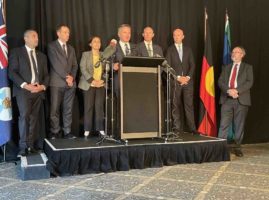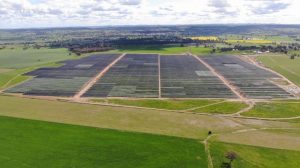The revival of Australia’s national renewable energy target could be the key to driving continued strong investment in new wind and solar projects, and could be the ideal complement to a proposed capacity mechanism, the Clean Energy Summit has heard.
Speaking at the Australian Clean Energy Summit in Sydney, Goldwind Australia’s John Titchen suggested a revival of the federal Renewable Energy Target could serve as an ideal ‘complementary’ policy mechanism to sit alongside a capacity mechanism and support strong investment in new wind and solar projects.
“I think one of the concerns is, does [a capacity mechanism] squeeze out the renewable transition in some way, by holding in existing assets?,” Titchen said.
“If the concern is the capacity market is going to squeeze out renewable growth, just extend the [Renewable Energy Target].”
“That would be a complementary mechanism. You don’t have to put carbon trading in place to do that.”
“Maybe carbon [pricing] would be the better way, but politically, it looks sort of impossible. The RET’s there, why don’t we use that?”
While the federal Renewable Energy Target remains in force the target imposed by the mechanism remains fixed at its 2020 level, where it will remain until the mechanism expires in 2030.
The RET mechanism therefore largely remains dormant as a means of supporting investment in additional wind and solar projects, with current demand for new projects being driven by the cost competitiveness of the renewable energy technologies.
The RET was first introduced under the Howard government in 2001, and was significantly strengthened by the Rudd government in 2009. By setting annual targets for the growth of renewable electricity, the scheme helped underpin much of Australia’s early renewable energy investment, despite a threat it would repealed by the Abbott Government.
Australia’s energy ministers are currently considering the Energy Security Board’s proposal for the creation of a capacity mechanism into Australia’s main electricity market, as a means of ensuring sufficient disptachable generation capacity is available.
Chair of the Energy Security Board, Anna Collyer, told the Clean Energy Summit on Tuesday that the ESB had sought guidance from energy ministers on how an emissions reduction trajectory could be baked into the design of its proposed capacity mechanism.
Collyer said that ‘complementary’ mechanisms to support investment in cleaner energy sources was a common feature of capacity mechanisms that have already been implemented elsewhere.
“There’s many, many capacity markets around the world, many of which have been implemented to manage the transition, which tend to have the complementary emissions reduction mechanisms that go with them,” Collyer said.
“So that’s what we would like to get further advice on, so that we can do that in a deliberate way and build out what we see that we need, in terms of that right mix of resources.”
“It’s absolutely not our intention to squeeze out renewables. We can clearly say that the bulk of cheap, clean energy comes from wind and solar.
“It’s really around making sure we have the right complementary resources and the right transition path to secure the overall affordable, reliable, secure outcomes for customers.”
The capacity mechanism has proven controversial among some within the energy sector, particularly driven by concerns that it could slow investment in new wind and solar projects, by delaying the retirement of ageing coal and gas generators, have led to calls – including from multiple energy ministers – for the mechanism to focus only on clean energy technologies.
Transgrid CEO Brett Redman told the summit that energy ministers should focus on setting policies and trajectories that are focused on the longer-term outcomes, rather than getting too caught up on the short term dynamics of the market.
“The RET was ultimately successful for two reasons: One, it had a long term ambition and the second is it stayed the course and ultimately exceeded all expectations,” Redman said.
“Because of that, we need to do the same with the capacity mechanism: set a long term ambition and stay the course.”
“By having a steadiness of that policy and a firm ten-year view, we can keep the market settled in the short term by being a bit pragmatic.”
“Because if the lights go out, and we have more crises, the population won’t tolerate a long term discussion. They’ll focus purely on the short term. So we got to have something that gets us through the short term, but focuses on a really good long term ambition,” Redman added.









